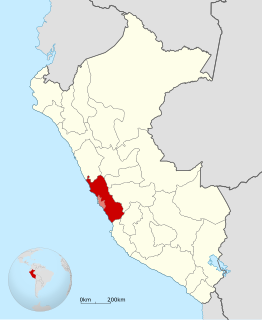Antioquia | |
|---|---|
 Plaza of the town of Antioquia | |
| Country | |
| Region | Lima |
| Province | Huarochirí |
| Founded | April 5, 1935 |
| Capital | Espiritu Santo |
| Government | |
| • Mayor | Luis Hilibrando Ramos (2019-2022) |
| Area | |
| • Total | 387.98 km2 (149.80 sq mi) |
| Elevation | 1,526 m (5,007 ft) |
| Population (2017) | |
| • Total | 1,225 |
| • Density | 3.5/km2 (9/sq mi) |
| Time zone | UTC-5 (PET) |
| UBIGEO | 150702 |
| Website | Official website |
Antioquia District is one of thirty-two districts of the province Huarochirí in Peru. [1]

The districts of Peru are the third-level country subdivisions of Peru. They are subdivisions of the provinces, which in turn are subdivisions of the larger regions or departments. There are 1,838 districts in total.

Huarochirí Province or Waruchiri is located in the Lima Region of Peru. Its capital is Matucana. The western section is part of the Lima Metropolitan Area.

Peru, officially the Republic of Peru, is a country in western South America. It is bordered in the north by Ecuador and Colombia, in the east by Brazil, in the southeast by Bolivia, in the south by Chile, and in the west by the Pacific Ocean. Peru is a megadiverse country with habitats ranging from the arid plains of the Pacific coastal region in the west to the peaks of the Andes mountains vertically extending from the north to the southeast of the country to the tropical Amazon Basin rainforest in the east with the Amazon river.







